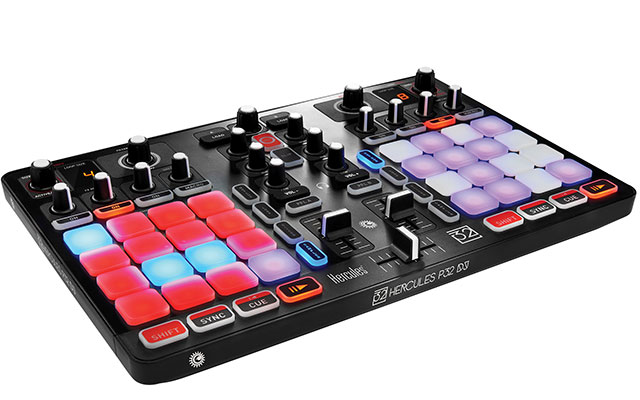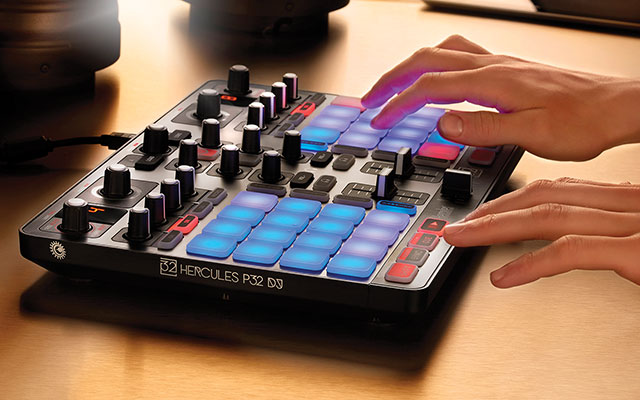Hercules has been making efficient and affordable DJ gear for nearly two decades now. And the French brand, owned by Guillemot and now distributed Stateside by Mixware, has delivered another winner – the P32 DJ controller.
The pad-heavy Hercules P32 DJ is quite a unit. Designed equally for DJing, live remixing, and on-the-fly sample-triggering, this portable, lightweight controller packs a mean punch. And I must say this to those DJs who don’t believe jog wheels matter anymore: You will love this little monster.
For the record, I am using a MacBook Pro 13-inch and the unit is just slightly wider and thicker than my laptop. Why is this important, you ask? Well, controllers were designed for a few primary reasons. In most cases, they were made to give users an all-in-one piece that, when paired with a laptop, gives the DJ total control to manipulate and play. It certainly does that.
Secondly, they were meant to be portable, so they should be light. And if you are like me, you’re often on the go—airplanes, trains, and Ubers—all day every day, so having a controller that can easily go from bedroom to booth without breaking my back is a major key for me. Thumbs up in that category as well.

OK, let’s talk about the unit itself. Some purist out there surely will say #RealDJing is with two turntables and a mixer. But, to that comment, I say: It’s 2016—get off your high horse. For me, if you can move the masses on the dancefloor, you’re a DJ and this controller allows you to accomplish that goal and then some.
At its purest form, the P32 is a two-channel player. I say “player” because it is more than just a DJ controller; it is a live remix tool comprised of the following elements: two channels (channel A and channel B), or for you old people (turntable A and turntable B); dedicated soundcard (RCA master and one stereo headphone output); 3-band EQ (high, mid, and low); four dedicated FX controllers with on and off kill buttons; Infinity Track navigation knob with load A and B buttons; Infinity Filter Knob; and Infinity Loop knob and corresponding loop size display.
The unit offers 32 RGB backlight performance pads (16 per channel) and you’re able to toggle back and forth between Hot Cues, Loops, Slicer, and Samplers. There is, of course, also a sync button.
In addition to the controller, the Hercules P32 also includes a free copy of DJUCED 40° 3.0 software, which feels like a hybrid of Serato/Traktor and Ableton. At its core, it will allow you to DJ and layer in FX, vocals, and samples over the top, essentially everything that the modern DJ needs—and where I personally think DJing is heading. So… here’s how I played with the unit:
Style-A (Traditional DJing): While each DJ will have their own style, I really found there were a couple of styles/ways to play on this unit. The first is the most common, with track-A playing on the left and loading and cueing track-B on the right, and fading from A-to-B and then again back to B-to-A.
In order to accomplish this activity, a DJ can utilize headphones—or the world-famous sync button, which some will say is cheating. But, once again, it is 2016—stop worrying about beat-matching and start getting excited that you can do so much more.
Style-B (Modern-Day DJing): At the core, Style-B, which I’ll call “peppering,” is foundationally Style-A with some added flair—but it’s that flair that takes you from a DJ to a mover of masses. So just like in Style-A, you are playing track-A into track-B; however, in this case you are adding layers on top of a single track, both tracks, or the mix itself.
On each A and B side of the controller there are four assignable FX knobs, which can be used individually or layered together. Personally, I love the Reverb and Delays, which just add that warmth to the track and some fun, playful sounds.
A second method of “peppering” is to add vocal samples and loops over top of a track. While this is slightly more difficult to get right (vs. just playing track-A into track-B), it can really make your set that much more special when it’s done right, because it’s all happening live and in-the-moment.
In my time as a DJ, I have only used FX with my sets, but with these performance pads, it made it so easy and user-friendly to add those additional layers and elements that it made me rethink how I want to play moving forward.
Lastly, when it comes to peppering, the fan favorite is the Loop Roll and, with the unit’s display of the loop size, executing loop rolls that sound right was easier than I have ever experienced on any controller. While this sounds like a small detail, I love loop rolls; but if you mess them up, they end up being out of sync, so having that display made mixing two tracks (while one is in loop roll) super-straightforward, easy and fun.
Style-C (Performance Mode): The third way I played took a bit more prep, in terms of finding the right samples and loops, but it was more rewarding. Essentially, I turned the controller into equal parts controller and live-performance piece.
So while track-A was playing, I would mix in just the kick-drum of track-B, then the bassline, then the melody. Basically, it was live remixing and mixing all at the same time. While I will never be the next AraabMuzik, I have to say playing around with drum kits, loops and samples certainly got me thinking differently about how I play and also how I produce. Anyone who is an expert finger-drummer will find these pads extremely responsive. The fact that they are RGB backlight means you can assign colors to different sample types.

The Build: Already, we mentioning that the size and weight of the controller was a real plus. The build quality of the regular knobs and Infinity Knob were made to last. Having a small screen to provide real-time feedback on loop size is something I personally love and it allowed me to do loop roll without having to look at the laptop. Four FX knobs per channel with kill switches is something we are seeing more of from all manufacturers, but it’s still always welcomed.
Where I thought the unit felt slightly short was with the volume and crossfade sliders. While I understand plastic components keep costs down and provide a lighter unit, I thought that aspect of the controller could have been improved. Call it a quibble.
For me, the shining light of this controller—and where it really separates itself from the pack—are the 32 performance pads, which are all extremely responsive, big enough for anyone with sizeable hands, and backlight RGB, which is an absolute must.
For in/outs, there is an RCA output and a USB input to connect from your laptop to the controller. The headphone jack was located on the side of the unit, which I thought was a little strange because my headphone cord from time to time got in the way when I was playing with the performance pads. But, as long as you have a headphone cord that is over three meters, you shouldn’t have an issue.
Conclusions: For the bedroom DJ or someone who is just starting out with DJ and or live performance, this unit is perfect. The compact size makes bringing this piece from the bedroom to the party an easy task and the addition of performance pads will allow you to take a standard DJ set to the next level.
Expect additional mappings for Traktor DJ and Virtual DJ to be available soon and that will only further the flexibility and usability to DJs who are already deeply ingrained in those digital DJ solution. At an affordable $249 retail price, the P32 DJ should make some noise.








